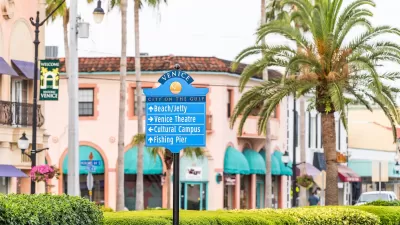Steve Rose surveys the scene at this year's Architecture Biennale in Venice, where he observes that the mood has shifted: "away from starchitecture towards something quieter, more collaborative and utopian."
According to Rose, this year's Biennale - regularly the most important event on the architectural calendar - reflects the new reality for a field trying to regain its footing following the crash of the high-flying real estate market of the 2000s.
"The theme for this year's Biennale, chosen by its British director David Chipperfield,
is Common Ground. It's a choice that hints at architecture's need to
refocus on issues like engagement and communication, on its need to
establish shared values. But as the Spanish students show, there are
chasms splitting the world of architecture. A divide is opening up –
generationally, economically and philosophically. The starchitects of
Trujillo's second reality are still here, but the appetite for
celebrations of individual genius, and isolated, beautifully crafted
buildings, seems to be dissipating. To co-opt the language of the Occupy
movement, the big names are starting to look like architecture's 1%."
In the search for stable ground, architects are gazing backwards to the mid-20th century when the pendulum had firmly swung in the other direction - away from designing and developing the trophy homes and buildings for the global 1%, and towards a social utopianism.
"Those were the days: when architects knew what needed to be done and
governments had the money to let them do it," says Rose. "Dutch superstars OMA,
for example, celebrate the work of anonymous architects in public
authorities across Europe from the 1960s and 70s. As OMA architect Reinier de Graaf
puts it, the era was 'a short-lived, fragile period of naive optimism –
before the brutal rule of the market economy became the common
denominator.'"
FULL STORY: Starchitects and squatters: Venice Architecture Biennale

Alabama: Trump Terminates Settlements for Black Communities Harmed By Raw Sewage
Trump deemed the landmark civil rights agreement “illegal DEI and environmental justice policy.”

Planetizen Federal Action Tracker
A weekly monitor of how Trump’s orders and actions are impacting planners and planning in America.

Why Should We Subsidize Public Transportation?
Many public transit agencies face financial stress due to rising costs, declining fare revenue, and declining subsidies. Transit advocates must provide a strong business case for increasing public transit funding.

Understanding Road Diets
An explainer from Momentum highlights the advantages of reducing vehicle lanes in favor of more bike, transit, and pedestrian infrastructure.

New California Law Regulates Warehouse Pollution
A new law tightens building and emissions regulations for large distribution warehouses to mitigate air pollution and traffic in surrounding communities.

Phoenix Announces Opening Date for Light Rail Extension
The South Central extension will connect South Phoenix to downtown and other major hubs starting on June 7.
Urban Design for Planners 1: Software Tools
This six-course series explores essential urban design concepts using open source software and equips planners with the tools they need to participate fully in the urban design process.
Planning for Universal Design
Learn the tools for implementing Universal Design in planning regulations.
Caltrans
Smith Gee Studio
Institute for Housing and Urban Development Studies (IHS)
City of Grandview
Harvard GSD Executive Education
Toledo-Lucas County Plan Commissions
Salt Lake City
NYU Wagner Graduate School of Public Service




























